#ogura hyakunin isshu
Text
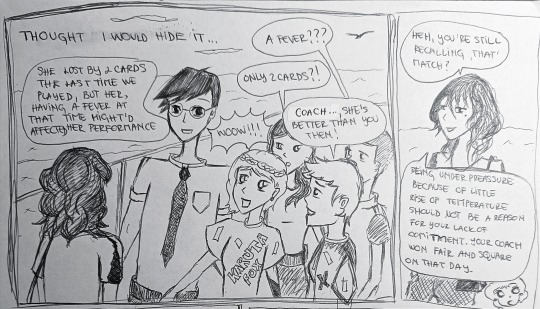
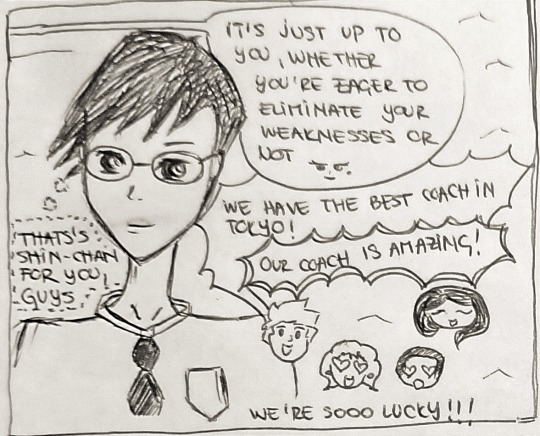
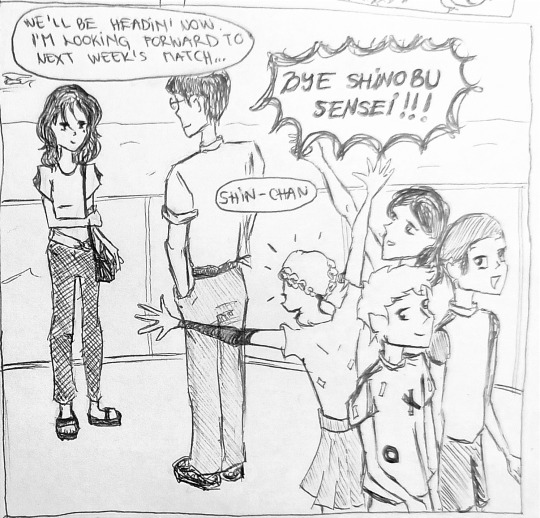

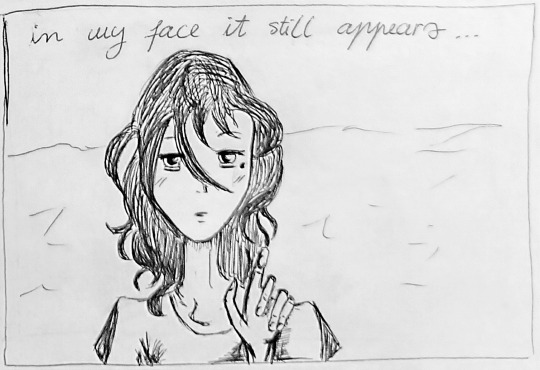
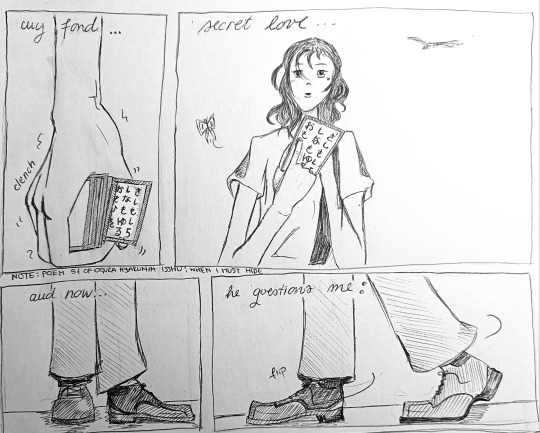
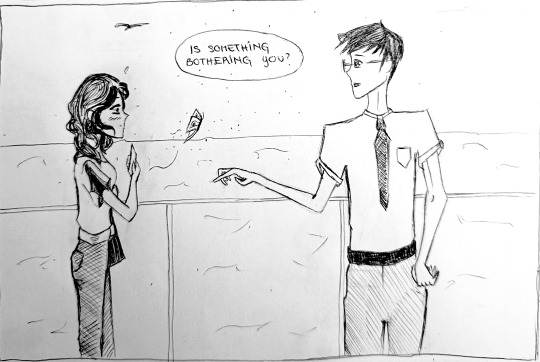
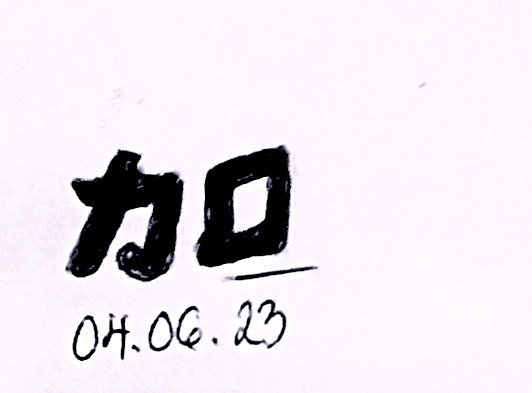
Chihayafuru fancomic of Shinobu and Arata
Don't know how the original author of Chihayafuru sees this pairing, but eversince the endin' of manga and even before I've got a constant feeling that they could be an endgame, eventhough there were so many fans opposing this fact. I simply had to draw it. My mind is bathing in the sea of ideas for these two. I tried to keep characteristics of both of them like it was shown in the manga and nail their possible reactions how they'd be if the story continued. If there's no suitable fanfic or fancom, it's best to do it yourself.
To explain the possible misunderstandings in the fancom:
Shinobu wants to confess to Arata, but she doesn't know how and when. The night before, she stares at the cards and one of the 100 poets starts talking to her. That poet is Fujiwara no Sanekata. He suggests her that the best way to confess one's feelings is to do it with honesty, using the original way of an individual. There she decides that she will choose a card which best explains and expresses her feelings towards Arata and then she'll give it to him. She chose Fujiwara's poem (poem 51): When I must hide these burning feelings, I feel as though my body is on fire with Ibuki mugwort.
かくとだに
えやはいぶきの
さしも草
さしも知らじな
燃ゆる思ひを
(i've never learnt kanji so i hope i drew it right in the comic and deeply apologize if not)
There's one more poem that i used and that's Shinoburedo. It's mainly because it's Shinobu's card and secondly because this poem gave me the main idea for the drawing in the first place.
Taira no Kanemori
Shinoburedo
Iro ni ide ni keri
Waga koi wa
Mono ya omou to
Hito no tou made
Though I would hide it,
In my face it still appears--
My fond, secret love.
And now he questions me:
"Is something bothering you?"
忍ぶれど
色に出でにけり
わが恋は
物や思ふと
人の問ふまで
As she prepares to give the 51st card to him, she recites herself verses of the Shinoburedo poem (that poem'd definetely calm her down), because she realises that she's starting to blush and that it's not simple to hide her feelings anymore, and that those feelings of hers won't be a secret anymore, At the end the one to finish reciting is not her, but Arata, who brings ancient poetry into reality, giving an opening chance for Shinobu to give him the confession and the answer Arata's expecting.
Sources for this fancom:
#anime#fanart#fan comic#fan manga#chihayafuru#chihayafuru manga#shinobu wakamiya#arata wataya#taichi mashima#chihaya ayase#shinobara#arata + shinobu#taichihaya#taichihaya 2023#fandom ships#karuta#ogura hyakunin isshu#japanese poetry
7 notes
·
View notes
Quote
逢ひ見ての
後の心に
くらぶれば
むかしは物を
思はざりけり
I have met my love.
When I compare this present
With feelings of the past,
My passion is now as if
I have never loved before.
Fujiwara no Atsutada (権中納言敦忠)
Other translations:
Having seen you,
my feelings afterwards –
if I compare them to
those in the past –
I have never loved before.
How I longed for you
before we had made love.
Yet when I compare
my heart since then
to what it was before
I know I had not grasped at all
what it is to love.
#poetry#japanese literature#japanese poetry#Ogura Hyakunin Isshu#hyakunin isshu#translation#waka#love#past feelings#true love#fujiwara no atsutada
7 notes
·
View notes
Text
Now we part. The pine-tree grows.
There on the Inaba mountain top.
If thou shouldst say "pine"
I to you will soon return.
Poem XVI of the Ogura Hyakunin Isshu by 中納言行平/Chūnagon Yukihira
#love almost all poems in this collection#the “pine” refers to the tree as well as the feeling expressed by the lover#poetry#ogura hyakunin isshu#personal#like many I fell in love with this because of Chihayafuru
1 note
·
View note
Text
Sukuna’s Wife and Yuuji’s Onee-chan (Sukuna x Reincarnated!Y/N) au headcanons
Other snippets of this au found here

When Sukuna awakened, he didn’t yearn for the scent of battle or the blood of the innocent. Before everything else, he felt your soul, and then he saw your face. Not an exact replica from the days gone by, but tiny pieces resonate here and there, beautiful in every way.
Far from a romantic, Sukuna had little interest in the arts outside of cooking.
Yet as he slaughtered the lowly thing that dared to lay eyes on you, the words of a dead emperor echoed in his mind:
Though a swift stream be
By a rock met and restrained
In impetuous flow,
Yet, divided, it speeds on,
And at last unites again.*
After a thousand years of fruitless searching, he has found his other half. The swift waters, long separated, have finally reunited.
However–
“Nee-chan, do something about this guy, he keeps talking crap about me when I’m trying to sleep!”
“You’re the King of Curses? So lame, can’t even take over a teenager? Boring. I could take you down.”
He could handle the annoying pink-haired brat’s yapping, and he will take care of the polished turd that called itself “Gojo Satoru” in due time. Sukuna’s main problem was something far more depressing.
“Darling, please feed me too,” he requested from Itadori’s cheek.
You lifted a piece of bread but instead of offering it to Sukuna, you directed it to the brat’s mouth.
“Beloved–” he would start, but you’d turn away with a harrumph. Then the white-haired turd would burst out laughing.
“Sweetheart, if you won’t look here, I will make sure this brat won’t get a wink of sleep.” Your only reply was a chilly snarl.
Of course, any husband would be disheartened by the sight of his wife glaring, but Sukuna was a special case.
He loved the attention. He’d rather you slap and hit him than ignore him. He preferred your warmth more, but this poisonous disdain of yours burned him in a deliciously different way.
He yearned for your gaze, no matter the cost.
It’s easy to look at Sukuna and think that he is a mega super sadist dom. Well, you’re wrong. He is a total wife-con. His greatest earthly treasure is you, so of course he will treat you with care. You’re the only one who will ever have him on his knees. You could snap him in half and he’d lick your toes in gratitude.
As stated above, he yearns for your attention, so he will do and say anything to have that. A millennium of loneliness has twisted his desires in the most grotesque way possible. He doesn’t want you to hate him so he can’t bring himself to kill the brat you cherish, but he will maim Yuuji just to hear your voice crack from screaming.
He really wants a physical form. One he can freely move in, so he can court you properly, like he did way back when. If words cannot convince you, then maybe he can remind your body why you loved him so much in the past.
If you were miraculously able to return his affections, he’d be waaaay easier to manage. One word from you can stop his rampage. Even if you were deceiving him to control him, he wouldn’t mind so long as you stayed by his side.
[1] A poem by Sutoku-In. Lifted from: The English translation of Ogura Hyakunin Isshu from Hyakunin-Isshu (Single Songs of a Hundred Poets) and Nori no Hatsu-Ne (The Dominant Note of the Law) by Clay MacCauley Yokohama: Kelly and Walsh, Ltd., 1917. Source: https://jti.lib.virginia.edu/japanese/hyakunin/macauley.html.
If you have any questions regarding this Sukuna and this version of Reader, feel free to ask cause I’m running out of stuff to say unprovoked.
@shadowywizardarcade @hannya-exists @nineooooo
@lilachaeyo @pumpkindudeishere @jessbeinme15 @fluffy-koalala @cringeycookies @frogzxch @isimpfordanielpark @marvelsgirl4ever @sanzusmom @sheccidoscar @marvelsgirl4ever
A/N: My unhealthy obsession with yandere fluffy husband Sukuna is the epitome of #ICanFixHim. (Disclaimer: This should go without saying but in real life, don't ever stay with a guy believing you can fix him. You’ll end up dragging each other down.)
#jujutsu kaisen#jjk#sukuna x y/n#sukuna x reader#sukuna#reincarnation au#husband#yandere#married#married au
334 notes
·
View notes
Text

Ogura hyakunin isshu (One hundred poets, one hundred poems). 1680.
"This illustrated book of Ogura hyakunin isshu (One hundred poets, one hundred poems) is a collection of one hundred 31-syllable classical Japanese poems (waka), each by a different poet. The collection is organized chronologically from Emperor Tenji (626-671) to Emperor Juntoku (1197-1242). Each of the poets is depicted by a woodblock print created by Hishikawa Moronobu (1618-circa 1694). Morobonu is often considered the first Ukiyo-e artist." Library of Congress
LOC
62 notes
·
View notes
Text
Where It All Began: Mount Ogura
Hello everyone,
I just returned from another trip to Japan,1 and we got to spend a bit of time in Kyoto. By accident, I also found Mount Ogura, and the place where Hyakunin Isshu was compiled! But first, let’s backup and explain a bit of history first.
Kyoto was the capital of Japan from the 8th century to the 19th century, and so many well-to-do families lived here. This aristocracy wrote…

View On WordPress
#Fujiwara no Teika#Hyakunin Isshu#Japan#Japanese history#Japanese Poetry#Karuta#Kyoto#Travel#Waka Poetry
4 notes
·
View notes
Text
Taichihaya week 2023 poems
There are multiple translations of the Hyakunin Isshu poems.
Here there are some of the translations of the poems that are prompts for this year's week.
I'll go in order of day by day of Taichihaya week.
Poem 81: Ho
Hototogisu
Nakitsuru kata wo
Nagamureba
Tada ariake no
Tsuki zo nokoreru


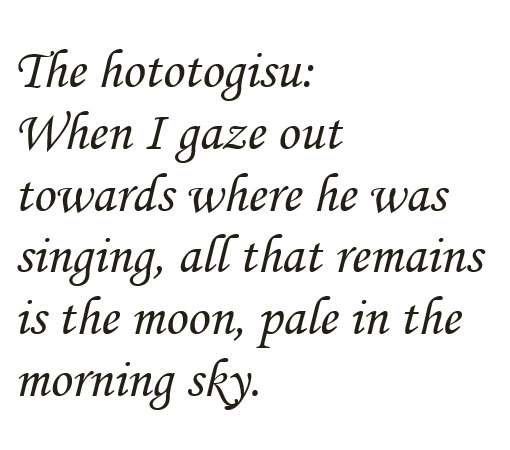
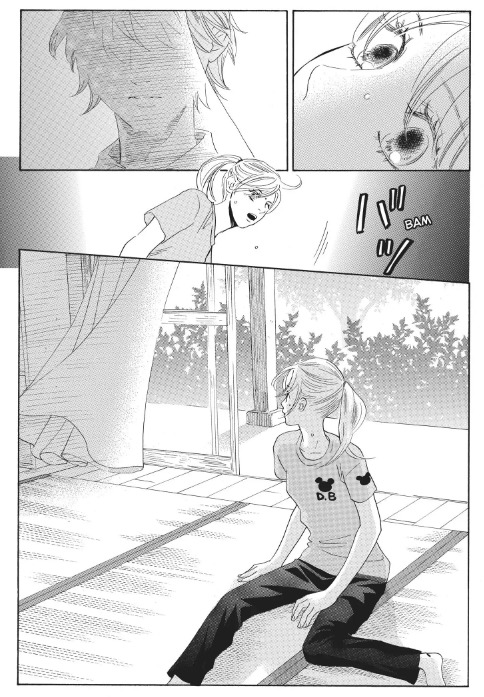
Poem 46: Yura
Yura no to wo
Wataru funa-bito
Kaji-wo tae
Yukue mo shiranu
Koi no michi kana
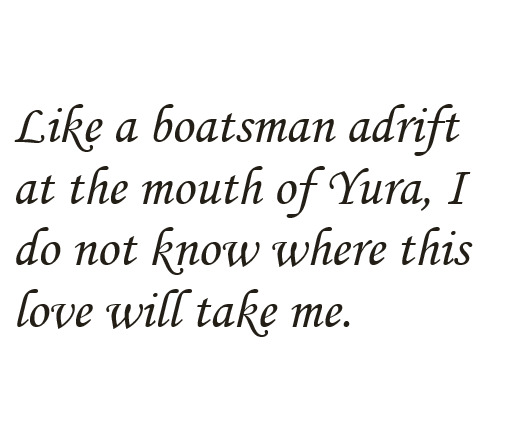
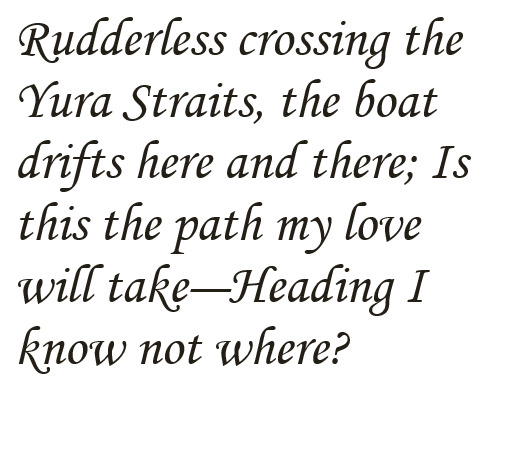
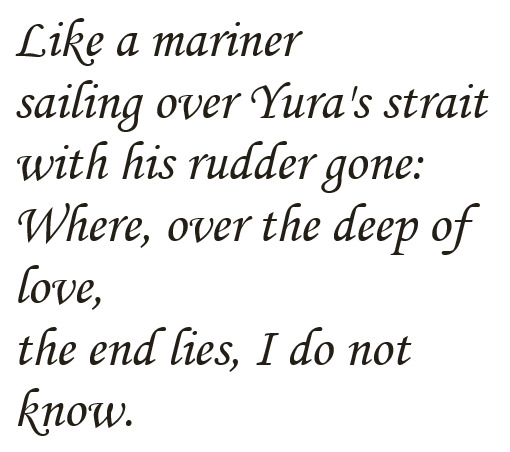

Poem 15: Kimi ga tame ha
Kimi ga tame
Haru no no ni idete
Wakana tsumu
Wa ga koromode ni
Yuki wa furitsutsu

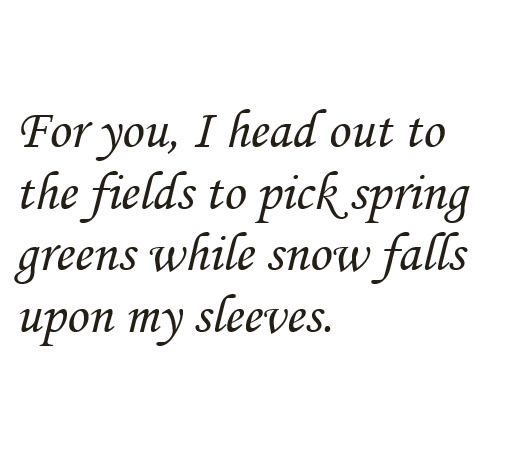
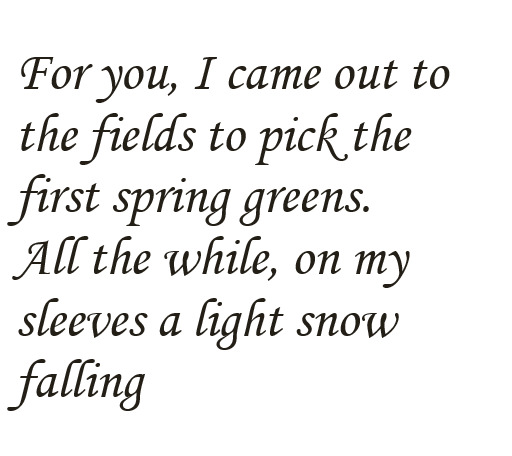

Poem 34: Tare
Tare wo ka mo
shiru hito ni sen
takasago no
matsu mo mukashi no
tomo naranakuni
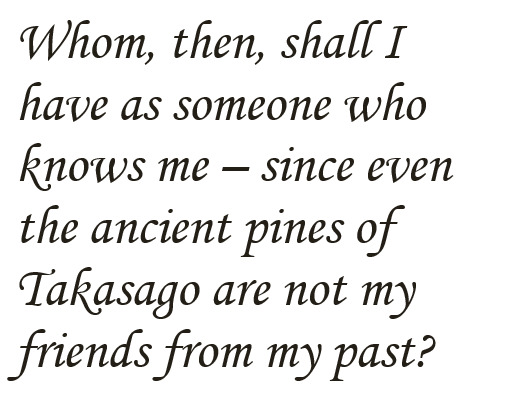
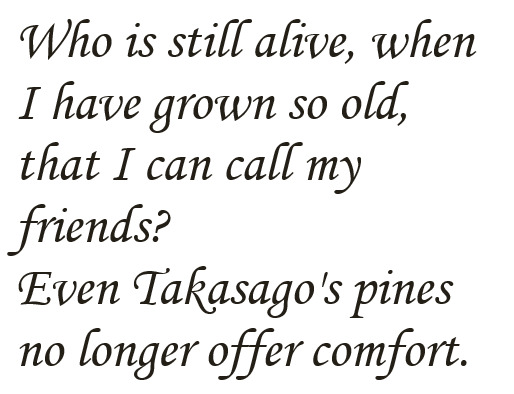


Poem 18: Su
Sumi no e no
Kishi ni yoru nami
Yoru sae ya
Yume no kayoi ji
Hito me yoku ran
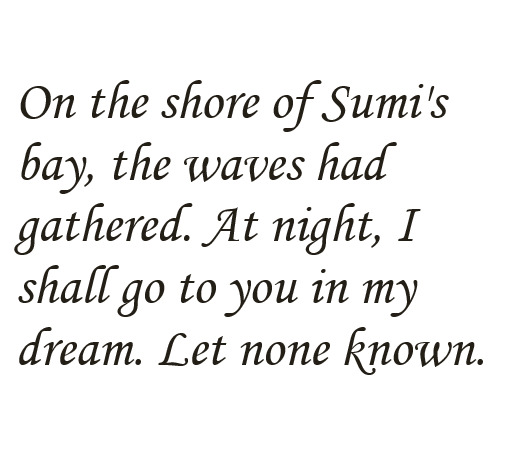

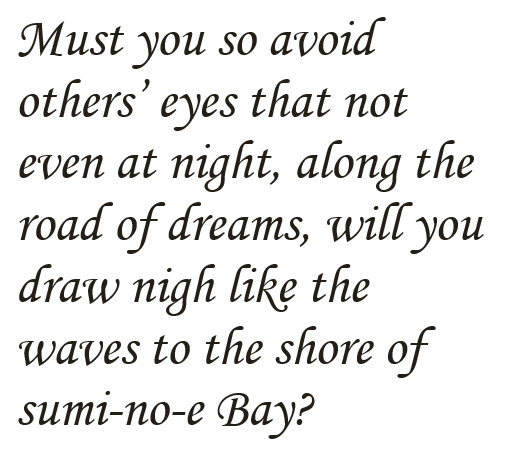

Poem 51: Kaku
Kaku to dani
Eyawa ibuki no
Sashimogusa
Sashimo shiraji na
Moyuru omoi o
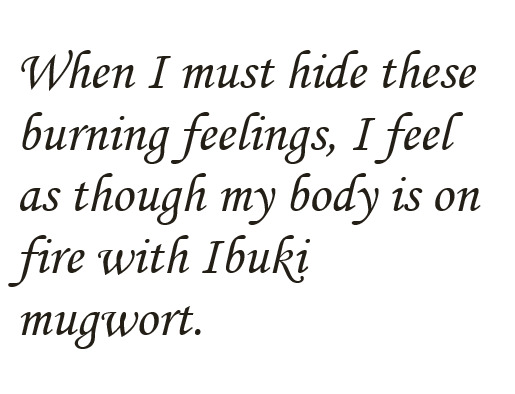
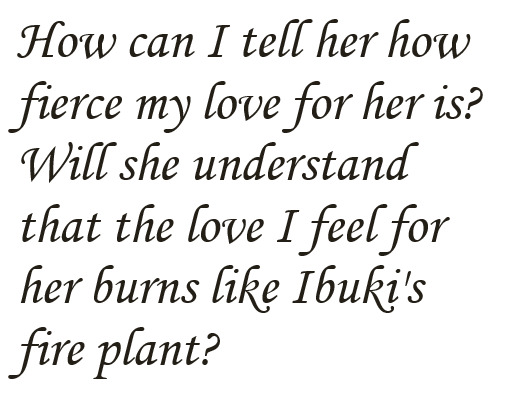


Poem 13: Tsuku
Tsukuba ne no
Mine yori otsuru
Minano-gawa
Koi zo tsumorite
Fuchi to nari nuru

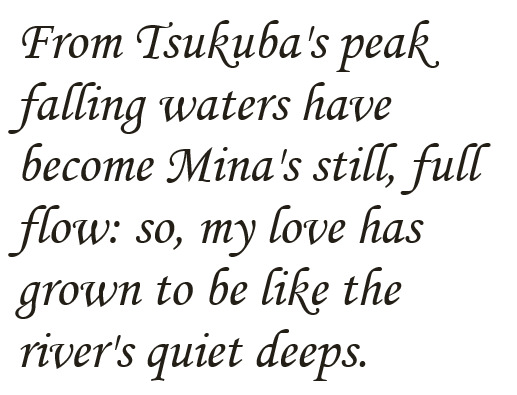
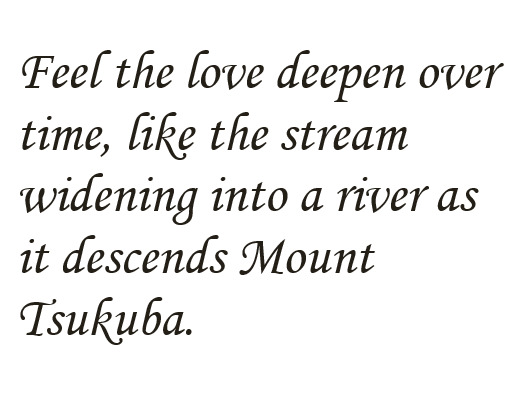
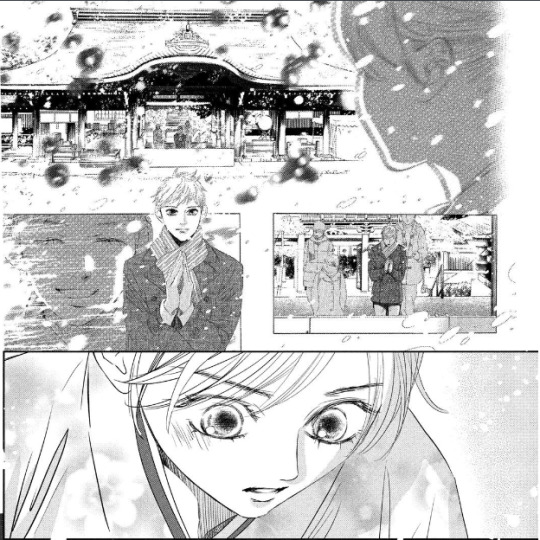
There are more poems associated with Taichihaya; we had to narrow them down to only 7. But another poem can also be used on day 7 with a "free prompt".
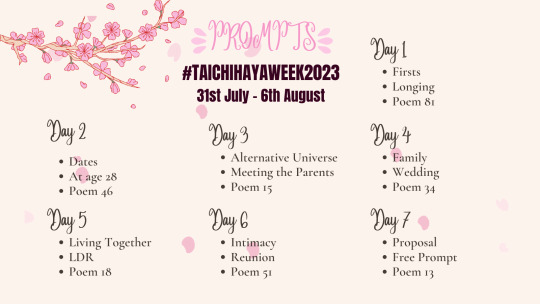
Other translations and other poems can be found here:
Also, I used some panels for each poem here. But their relation is not unique to those panels; each poem extends to way more moments and aspects of taichihaya.
49 notes
·
View notes
Text
Day Four; Tea Fields:
On the third day, the group will head to Uji, a city for the cultivation of tea. On this day the group will take a hike around the tea fields, and hand-pick tea leaves to later make into tea. This will allow everyone to relax for a morning and take in the scenery, hiking around and appreciating the natural wonders of the time.
During the afternoon there will be an opportunity to visit the Byodoin temple and engage in a meditation session with a Buddhist monk. However, if the group would rather continue with their exploration of the natural world of the period the choice is theirs.
Later in the evening, there will be a poetry gathering held. Where the group will get a chance to meet some of the most influential and talented poets and authors of the period and learn from them how they mastered their craft. Some notable people who may join would be;
Murasaki Shikibu, a novelist, poet, and one of the ladies-in-waiting at the imperial court is best known for her novel The Tale of Genji, which is acknowledged to be one of the earliest written novels, published between around 1000 and 1012.
Koshikibu no Naishi, a Japanese poet whose work was included in the Ogura Hyakunin Isshu.
Fujiwara no Kinto, also known by the name Shijo-dainagon, who was a poet who was also a court bureaucrat during the time.
And many more.

2 notes
·
View notes
Text
Reflections on Tableturf
This blog post goes through a few of my Tableturf inspired artworks from 2023, ending with a quick timelapse of this painting:
With the launch of Splatoon 3 came a new game mode, Tableturf! I got quite into the idea of Tableturf, even being a part of coordinating an art collab project – Arty Siege – which paid homage to the in-game cards. I did lots of work for that – creating various design elements, having fun data merging artwork in InDesign, thinking about how the physical game would really play out, coordinating artists and creating artwork!
The art that I worked on included assets for the card backgrounds, and I illustrated one of the cards.
These background images were ink paintings traced from game screenshots. After doing a little photography tour in the game I exported the screenshots and used the Find Edges filter in Photoshop. I printed these reference lines to carbon paper and transferred them to watercolour paper.
After scanning the ink paintings, I applied some gradient map adjustments to them to adapt them into the card background.
I chose to illustrate the Splattershot Jr. as my designated card for the project. I’ve drawn the newbie squid before and as a Junior player (I became a Junior main because of having to unlock kits on many, many systems) I just feel a certain connection to the default loadout.
During initial project advertising, I used this artwork. The pose is taken directly from the pose of the original Tableturf card. With this version of the artwork, I mocked up the first version of how the cards would appear, including tweaks to the card UI and creating a 3D view of the card.
My motivations for changing the UI were to make the Arty Siege cards distinct from the in-game works, but also to think about what would make sense for a real card game. The original cards put all their important information at their base, but I wanted to make all the pertinent information visible easily from a fanned out hand of cards. So I moved the grid and special costs to the left side.
I also straightened the alignment of the block grid. The angled grid was cool, and saved a little space, but I felt that when looking down at the game board and determining how to make a move, it was easier to visualise the move you wanted to play by having an aligned grid. Maybe that was just me, it’s not like things in the real world would be completely squared anyway.
Anyhow, relatively late into the project I started feeling a bit insecure about that version of the Junior being my entry into the project. I was surrounded by an incredibly talented pool of artists and felt like I needed to step up to the standards of my peers! I still like my original artwork but I also felt inspired by the work I’d done on the backgrounds to do a piece in ink and use gradient mapping to add colour.
This time, I based the pose on some promotional artwork from Splatoon 2 – I wanted to show off the square ink tank because while the flat ink pack of Splatoon 3 features in some of the cards, many of the other ones seem to take cues from Splatoon 2’s fashion options.
Here’s the final version of the Splattershot Jr. card. Please do check out the Arty Siege website for all of the other works!
One of the things I did at the end of this project was to print out all the cards, which was a lot of fun! I felt like I built a new connection with each of the artists and their artwork in the process of printing, cutting and sleeving the cards.
While wrapping up Arty Siege I had a vague idea of running a promotional Tableturf tournament – maybe something in a casual vein, or with a bit of a team gimmick to allow a mix of player skills among drafted teams. The team angle was influenced by my favourite anime – Chihayafuru – a show that features a competitive karuta game based on the Ogura hyakunin isshu.
Chihayafuru is beautiful, and the way it depicts friendly competition really hits home. And there’s just something so great about the earnest enthusiasm of the players – they’re engaging in a pretty niche hobby so having the opportunity to play is something they’re truly grateful for. Coming from a grassroots Splatoon scene, I feel the parallels between the competition depicted in the show and some of my favourite times being a member of the Australian (and broader) Splatoon community.
I wish competitive video gaming was filled with people as kind and grateful for the opportunity to play with others as the karuta players in Chihayafuru.
— David Michael Kinne (@Mewd462) May 18, 2019
This kinda sums it up!
Although I didn’t end up running a Tableturf tournament, the imagery and the idea for an art piece stuck with me.
As much as I adore Chihayafuru, I’ve never felt brave enough to try to tackle fan art for it. The gorgeous scenes, the sense of movement, the game that I only have the most superficial understanding of… it all felt quite intimidating.
But Splatoon, I feel comfortable in that universe…
(A universe which coincidentally seems to have a version of karuta already!)
However, my painting is not an attempt to retcon that karuta into Tableturf. In my headcanon, the two coexist. I just wanted to borrow the aesthetics of karuta for my Tableturf scene. I was inspired by the glowing sunset scenes of karuta which I associated with the characters practicing in the school clubroom, but also by the tournament games played while wearing kimono.
Before starting this painting I did two “mood studies” – just getting a feel for whether I could tame the contrast of yellows, oranges and purples before I started. Watercolour can be a tricky medium, and it’d be hubris to walk into this kind of endeavour without a plan.
That first image is sort of a Chihayafuru fanart, I guess – the scene is most likely Arata sitting alone with his cards – but that wasn’t the purpose of the sketch. I wanted to get a feel for how I’d depict the trees in the windows, and the light entering the room. The second sketch really sets up the composition that I’d ultimately use for the final piece.
After deciding on that sketch, I made simple 3D version of the scene in Blender.
A digital sketch then filled in the character details
Which was then printed out and transferred to stretched watercolour paper, then painted over the span of a few weeks.
I also wrote a poem to go with this painting. It’s based on poem 77 of the Ogura hyakunin isshu. Here’s one blogger’s translation and writeup about the poem (I chose to highlight this blogger because they also have a post about the Karuta that appears in Splatoon 2!)
The translation included in that post is credited to Joshua Mostow,
Because the current is swift, even though the rapids, blocked by a boulder, are divided, like them, in the end, we will surely meet, I know
Other translations summarise the scene as
Swift waters parted by the jagged rocks are joined at river's end.
The overall mood that I get from this poem, having only experienced it through translations, is a mix of urgency and yet steadfast certainty that comes from love. Apparently, the “swift currents” were not in the original poem, and were a later edit, but I think the imagery is certainly much stronger with the idea of rapid waters.
I felt the scenario could be mapped quite closely to the energy and movement of Turf War, and by extension, Tableturf. The rapid currents can be whirls of paint instead, and the boulder standing in the way of the lovers could well be a grey block, created in Tableturf when both players play their cards over the same squares.
I chose to write my poem following the rough syllabic rules of the original poetry, the lines having 5-7-5-7-7 syllables. But I put a western poetic spin on them as well, making use of rhyme throughout.
Our rapid advance, Blocked by chance or wit wherefore. Must we halt our dance? No - surge forth in this turf war! We'll unite our ink once more.
The rapid advance describes that rush to claim turf, as well as for the rivals/lovers to meet at the middle of the map. “Chance or wit wherefore” refers to how the grey block ended up in their way. Was it coincidence that they played in the same tile, or was it cunning strategising from one of the players? With this obstacle in place, the shape of their relationship (whether it be a rivalry or a romance) is affected.
The ending couplet describes the characters choosing to rise above (or work around) adversity – in-game the boulders would not be passable at all, so they must certainly have some grit! Like the swift waters in the original poem, they’ll be sure to meet again.
I love how this artwork and poem came together. Reflecting upon them I feel all those warm fuzzy feels from all the ways that Splatoon – and more recently Tableturf – have made their impact on me. I’m grateful to have had another great year of art, friends and community and I’m looking forward to more good times in the future.
"Reflections on Tableturf" was originally published on Proairesis
0 notes
Text
tanabata

Tanabata, sometimes known as Star Festival, is a Japanese holiday that falls on July 7th. It originally came from the Chinese holiday Qixi, but is celebrated in its own way in Japan.
A quick and slightly related fun fact: lucky numbers in Japan are 3, 5, and 7. There's a holiday called Shichigosan, literally meaning 753, in which children who are turning 7, 5, or 3 years old dress up and go to a shrine to celebrate and wish for good health. Because of this, some of Japan's biggest holidays also occur on days with these numbers. Hinamatsuri, celebrating young girls is on March 3rd (3/3). Children's Day, historically celebrating young boys but now including all children, is on May 5th (5/5). And Tanabata, the Star Festival where people make wishes, is on July 7th (7/7)!
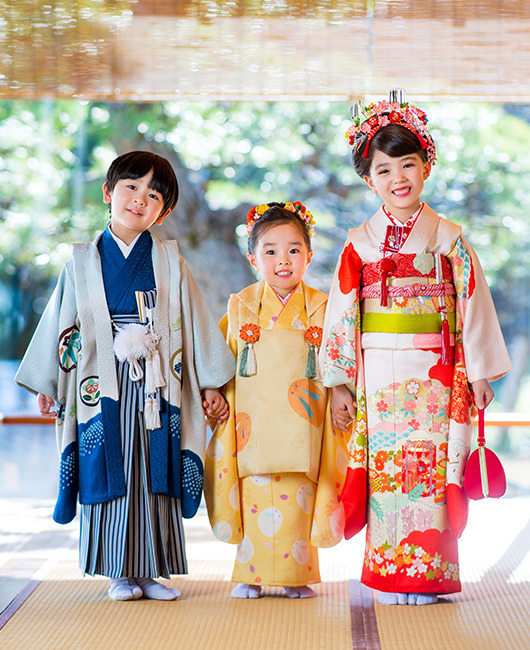
Okay, back to Tanabata. According to the folktake on which it's based, there was a man named Hikoboshi and a woman named Orihime. Orihime could weave beautiful cloth and spent all of her time down by the river weaving for her father. She became upset over time that she spent so much time weaving and she couldn't fall in love. Her father then allowed her to marry Hikoboshi, a cow herder from across the river. The two fell in love, but soon Orihime became distracted in her romance and couldn't complete her weaving duties. This angered her father and he forbid her to see her husband again. She pleaded with him to let them meet, and he decided that he would allow them to cross the river and meet each other only once each year on the seventh day of the seventh month. The first time that the couple were to meet, they found there was no bridge to cross the river. Orihime wept, but a group of magpies appeared and created a bridge for them to cross. Now it's said that if it rains on Tanabata, the magpies are unable to come and make the bridge, so the rain on Tanabata is now called "the tears of Orihime and Hikoboshi." This story was centered around the stars of Vega and Altair (Orihime and Hikoboshi), separated by the Milky Way (the river), which is why it's called the Star Festival.

Because this story is of young lovers, the holiday is celebrated by couples in China as a kind of Chinese Valentine's Day, but in Japan it's celebrated by everyone and seen as a holiday for making wishes.
Since I'm a big fan of old Japanese poetry, particularly the Ogura Hyakunin Isshu, here's a special poem representing Tanabata:
かささぎの
渡せる橋に
おく霜の
白きを見れば
夜ぞふけにける
If I see that frost-covered
heavenly bridge
spanned by magpies
I'll know the night
has drawn to a close
This poem was written to compare the Orihime and Hikoboshi folktale to the frost-covered steps of the imperial palace on a dark winter night. Thus this poem evokes strong and beautiful winter imagery while also alluding to the famous Star Festival. It was very popular for traditional poetry to include double meanings combining natural scenery and cultural references.
The most popular custom during the Tanabata season is writing wishes on colored strips of paper and tying them to a bamboo tree. During this time, I can see many Tanabata bamboo trees in my schools and other public places, but surprisingly, few Japanese people keep them in their houses. They are more of a public event shared together outside of the home.

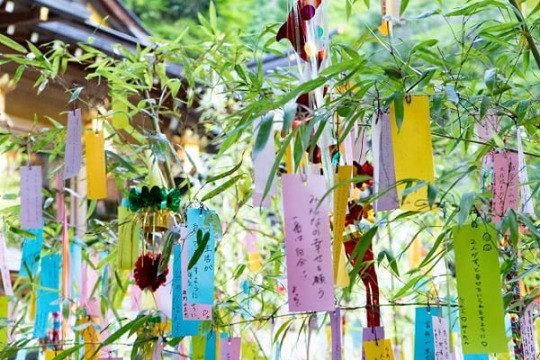
I even saw one at my car repair shop. I had gotten a flat tire, so I wrote a wish on the tree hoping that my car would be safe from needing further repairs, haha.
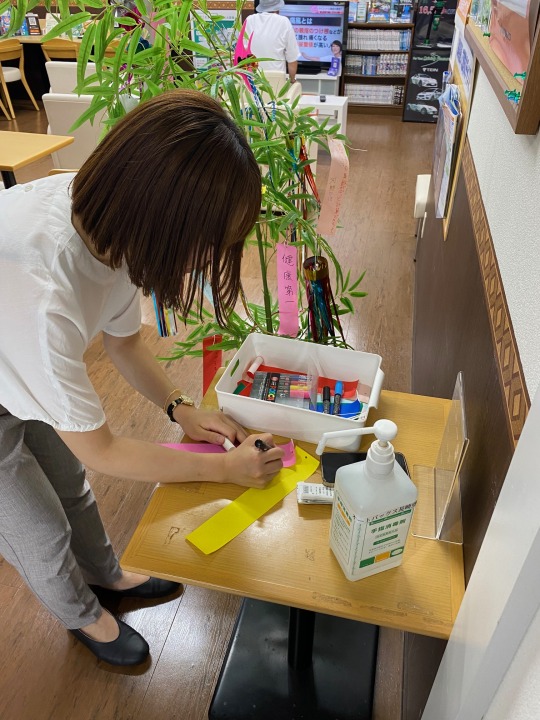
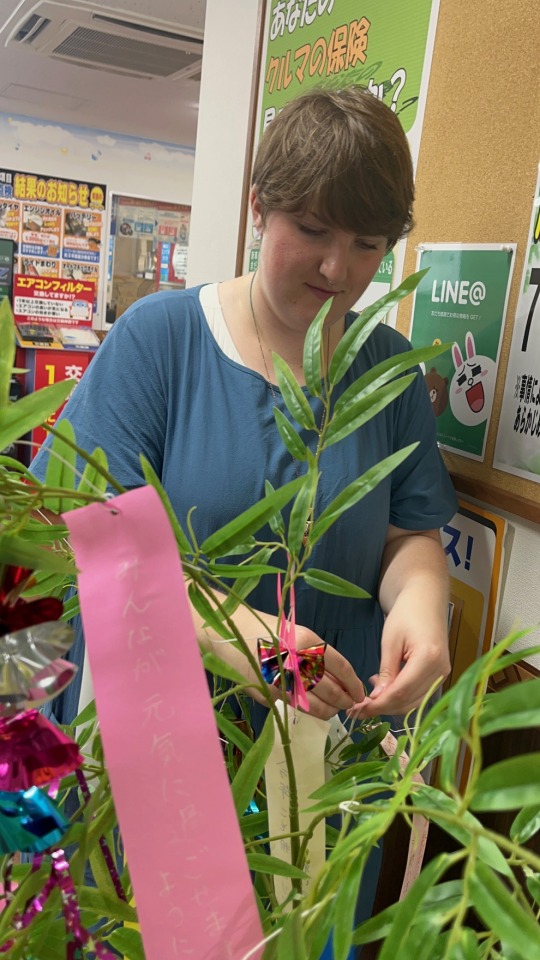

Tanabata is a fun holiday. I hope everyone's wishes come true!
0 notes
Text
Poesía.
Poesía completa, de Cayo Valerio Catulo
Poesía completa, de Antonio Machado
Ogura Hyakunin Isshu, de AA. VV
El collar de la paloma, de Ibn Hazm de Córdoba
Cuartetas persas, de Omar Jayam
Epigramas, de Lucio Anneo Séneca
Poemas, de Robert Louis Stevenson
Cuaderno de vacaciones, de Luis Alberto de Cuenca
Poesía completa, de Matsuo Bashō
Eternidades, de Juan Ramón Jiménez
Epigramas (volumen I), de Marco Valerio Marcial
Epigramas (volumen II), de Marco Valerio Marcial
Poemas, de Henry David Thoreau
Poesía completa, de Edgar Allan Poe
Poesía china (siglo XI a. C.- siglo XX), de AA. VV
Ecos de mi pluma, de Juana Inés de la Cruz
Literatura árabe, de Juan Vernet (ed.)
Belleza, de Juan Ramón Jiménez
El maestro de los cinco sauces, de Tao Yuanming
El gaucho Martín Fierro. La vuelta de Martín Fierro, de José Hernández
Literaturas del Anáhuac y del Incario, de Miguel León-Portilla (ed.)
Poemas del río Wang, de Wang Wei
El silencio de la luna. Introducción a la poesía de la dinastía Tang (618-907), de Javier Martín Ríos
Poesía completa, de Joan Salvat-Papasseit
Trece poetas del mundo azteca, de Miguel León-Portilla (ed.)
La pagoda blanca. Cien poemas de la dinastía Tang, de Guillermo Dañino (ed.)
Las primeras poetisas en lengua castellana, de Clara Janés (ed.)
Cantos de amor y de ausencia. Cantos “chi” de la China medieval, de Xu Zonghui y Enrique Gracia (eds.)
Poesía completa, de William Shakespeare
Antología de la poesía china, de Juan Ignacio Preciado Idoeta (ed.)
Cantares de Ise (anónimo)
Un puñado de arena, de Takuboku
Poesía completa, de Li Qingzhao
El ala y la cigarra. Fragmentos de poesía arcaica griega no épica, de Juan Manuel Rodríguez Tobal (trad.)
El cementerio marino, de Paul Valéry
Poesía acmeísta rusa, de Diana Myers (ed.)
Rubaiyat, de Fernando Pessoa
Poemas, de Nezahualcóyotl
Tres poetisas del Renacimiento, de Luis Martínez de Merlo (ed.)
La amada inmóvil, de Amado Nervo
Efímera, de Miguel Albero
Flores del Buda, de Yosa Buson
Poesía escogida, de Robert Browning
Antología poética, de George Brassens
0 notes
Quote
八重むぐら
しげれる宿の
さびしきに
人こそ見えね
秋は来にけり
To the dim cottage
Overgrown with thick-leaved vines
In its loneliness
Comes the dreary autumn time:
But there no people come.
The Monk Egyo (恵慶法師)
Other translations:
Tangled catchweed
residence rampant with weeds
lonely
I see no one
autumn has arrived.
And last, my personal favourite translation ❤️ :
How lonely this house
overgrown with goosegrass weeds.
No one visits me—
only the weary autumn comes.
#poetry#japanese poetry#japanese literature#Ogura Hyakunin Isshu#hyakunin isshu#translation#japanese#waka#loneliness#autumn#egyo hoshi
2 notes
·
View notes
Text
The Timeless Beauty of Hyakunin Isshu: An Odyssey of Translation through Classical Japanese Poetry. 100-Days of Translation - Day 1
The Timeless Beauty of Hyakunin Isshu: An Odyssey of Translation through Classical Japanese Poetry. 100-Days of Translation - Day 1
Let’s step into a realm of poetic brilliance. Together we’ll embark on a journey through the exquisite world of Hyakunin Isshu (百人一首), a collection of one hundred masterful poems from classical Japan. The most famous and standard version was compiled by Fujiwara no Teika (1162–1241) while he lived in the Ogura district of Kyoto.[1] It is therefore also known as Ogura Hyakunin Isshu (小倉百人一首). I…

View On WordPress
#ClassicalJapanesePoetry#CulturalConsultant#CulturalExploration#百人一首#DiscoveringBeauty#Hyakunin Isshu#HyakuninIsshu#JapaneseCulture#JapanesePoetry#PoetryEnthusiast#TimelessWisdom#TranslationAdventures#TranslationJourney#TranslatorsLife
0 notes
Link
Supremely excellent article on Chihayafuru’s namesake poem
#i guess in classical japan dakuten weren't the norm#if they existed at all#so the voiced 'bu' is represented by the unvoiced 'fu'#this becomes a vehicle of poetic ambiguity in another part of the verse#japanese language
0 notes
Text
Talking about Shoko.
Time for Shoko head canons so I can get out all the thoughts I have in my head about her. This got way too long so um I guess all my thoughts under the cut?
Part one. (?) If I get more thoughts about her I will also post them. I might have thoughts about adult Shoko, but this is mostly family + backstory at this point.
Shoko's parents are both sorcerers. It's a very minor sorcerer family, there's no inherited innate curse technique that's been passed along in her family (yet) but her family has always had sorcerers along the line. While her cursed technique came as a surprise that she had cursed energy did not.
Her mother Suzume Ieiri utilizes a variation on cursed speech (there is some distant relation between her mother and the Inumaki's). While not as powerful as being able to give simple commands, she can use her cursed energy through tanaka poetry using 31 syllables following along a 5/7/5/7/7 count. So as one can guess her mother is an avid fan of poetry.
Bonus mother head canon: she is a master karuta player, and since she has retired she has gone on to become a reader for karuta matches. she is highly ranked as a reader as well, and often is a reader for the queen / meijin matches. (for those of you who know where this head canon comes from, you know 😉.)
Bonus Shoko head canon: Shoko is lowkey kinda of a karuta beast too. She does have the 100 poems of the ogura hyakunin isshu memorized. She made it to level B before she had to transfer to JJ Tech. Sometimes when she's stressed she still goes and plays at a Karuta society in Tokyo. If her mom is reading for a match in the area or for the Queen / Meijin tournament she'll watch on tv.
Her father Kenji Ieiri was more of a brawler. His cursed energy would expand with the more damage he took, so the worse a fight was going for him at the start the stronger he gets later into the fight. With a certain amount of damage it just keeps doubling exponentially.
Bonus father head canon: now that he's retired he likes to garden. He grows and gives out an abundance of vegetables. He also takes care of the family cat. A little calico that he spoils in his empty nest days.
Both her parents made it to Grade 1 before her mother retired when she was pregnant with Shoko. Shoko is an only child, she was doted on by her parents.
They lived in a small town near the sea, her home a traditional Japanese home, too traditional she feels. It gets very cold in the winter. (Bonus Shoko Head Canon: She used to snuggle up with a hot water bottle a lot.) Her town is by the sea, Shoko has a particular attachment to the sea because of it. She lived a rather ordinary life. Her family sent her to school with the other children in her town.
Her curse technique developed when she was 5. Her father came home, badly injured, and while her mother went to get the first aid kit, little Shoko just reached over and healed him. Both of her parents were shocked. Reverse Curse Technique by itself is a rare thing, but to be able to use it on others is unheard of at least within recorded Jujutsu history. (There are of course, at least two Heian era sorcerers who could, but that has been lost to history.)
Her parents inform the higher ups the next day, they come to see her ability in person. They are shocked and more importantly over joyed. Such a power, such a rare and precious gift, such a blessing. It's arranged for Shoko to attend the school in Tokyo, as it's closer to her parents hometown. Until then she continues to go to school in her town through middle school.
Shoko has friends, boys she makes out with. She gets good grades. Has her first cigarette. And then they tell her she's going to school in Tokyo. Her parents are crying when it is time to send her off. Shoko is a little miserable primarily because she's going to be in class with the Gojo heir and another special grade and frankly she's sure they're going to be cocky assholes. Figures they'll make the whole thing really suck for her.
It doesn't though. She winds up bonding with, and caring for the two idiots in her grade. They're all so special. Two special grades and the only healer their world has seen in a thousand years. They could change the world.
Until they couldn't.
0 notes
Text

八重葎[Yaemugura]
Galium spurium var. echinospermon
八重[Yae] : Eightfold
葎[Mugura] : Trailing plant
It is one of the so-called weeds, distributed over a wide area in the Northern Hemisphere and commonly found. Yaemugura is said to be a general term for grasses that grow in multiple folds and entanglements, and was not a term exclusive to this species.
Well, there is a waka poem like this.
八重葎 しげれる宿の さびしきに 人こそ見えね 秋は来にけり
[Yaemugura shigereru yado no sabishiki ni hitokoso miene aki wa ki ni keri]
The dilapidated inn, overgrown with Yaemugura, is deserted, and not a soul is to be seen, but autumn has come nonetheless.
This was composed by a Buddhist priest named Egyō, and is included in the Ogura Hyakunin Isshu. Yaemugura also appears in Kiritsubo in the Tale of Genji, in many waka and haiku poems. And, there is also a story titled by that name, which was probably written around the end of the Kamakura period(1185-1333.)
https://en.wikipedia.org/wiki/Egyō
Although scenery of houses or mansions covered in weeds may seem shabby, people in the olden days found a sense of sentiment and beauty in things that were perishing. The concept of もののあはれ[Mono no aware] is one such example, and 侘び寂び[wabi sabi] in later generations has inherited it.
https://en.wikipedia.org/wiki/Mono_no_aware
While some plants have been given unfortunate names, this species has benefited from the name.
https://bunka.nii.ac.jp/heritages/detail/535958
17 notes
·
View notes